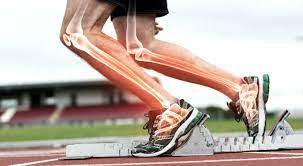Sports injuries are common and can occur throughout your body to bones, muscles, tendons, ligaments and other structures.
Read Also: Nigeria Secures Three Olympic Boxing Quotas Amidst Strong North African Dominance
You can treat many minor injuries at home with rest, ice, compression, elevation and over-the-counter pain medications. But some injuries require medical treatment, such as immobilization, physical therapy and surgery.
What are sports injuries?
Exercise is important to good health, but people often get hurt when participating in sports or other physical activities. A sports injury involves damage to part of your body due to sports, exercise or athletic activities.
A sports injury can be acute (sudden) or chronic (develop over time).
Who might get a sports injury?
Sports injuries can happen to anyone, particularly people who:
- Are out of shape.
- Don’t wear proper protective equipment.
- Exercise without warming up and cooling down.
- Participate in contact sports that may involve tackling or collisions.
- Take part in activities that involve jumping, running and pivoting or changing direction quickly.
What are the most common parts of the body injured?
Sports injuries can affect any part of your body. They most often affect:
- Achilles tendon: The Achilles tendon is a thick cord that connects the back of your lower leg (calf) to your heel. It helps you walk. But the tendon can become swollen, inflamed and stiff. It can even tear. This is called Achilles tendinitis or Achilles tendon rupture.
- Ankle: Your leg and foot join together at your ankle. It contains three joints, as well as several bones, cartilage, ligaments, muscles and tendons. Ankle pain is often caused by a sprained ankle.
- Elbow: Your elbow is the joint that acts as a hinge between your upper and lower arm. People often experience pain in their elbow from repeat motions and overuse (for example, tennis elbow and Little League elbow).
- Head: Your head includes your face, skull and brain. One of the most common head injuries is concussion.
- Knee: Your knee is a complex joint that acts as a hinge between your thigh and lower leg. It contains bones, cartilage, ligaments and tendons. Knee pain can be caused by jumper’s knee or runner’s knee. Other common injuries include meniscus tear and anterior cruciate ligament (ACL) tear.
- Shoulder: Your shoulder connects your upper arm to the trunk of your body. It contains your rotator cuff, a group of muscles and tendons that keep the upper arm in your shoulder socket. Rotator cuff tendinitis and rotator cuff tears are common sports injuries.
What are the most common sports injuries?
There are many types of sports injuries. Some of the most common are:
- Broken bone: A broken bone (bone fracture) can happen when sudden force is applied to a bone.
- Cartilage tear: Cartilage is a tough but flexible shock absorber that covers and protects the ends of some bones. Cartilage injuries can occur in joints such as your knee and shoulder.
- Concussion: A concussion is a brain injury caused by a bump or blow to your head.
- Dislocation: Dislocation occurs when the end of a bone moves out of its normal position in a joint. For example, if your shoulder pops out of its socket, it’s dislocated.
- Tendinitis: Tendinitis occurs when your tissues that connect muscles to bones (tendons) become swollen and inflamed. It’s caused by repetitive movements over time. An example is jumper’s knee (patellar tendonitis).
- Sprains: A sprain happens when a ligament stretches too much or tears. Ligaments connect bones and stabilize joints. These injuries can be mild or severe, and they’re common in your ankle, knee and wrist.
- Strains: A strain occurs when you overextend a muscle and it stretches or tears. Examples include hamstring strain, back strain and abdominal strain.
Symptoms and Causes
What causes sports injuries?
Sports injuries have many causes, including:
- Accidents, such as a fall.
- Bad habits with exercise, such as not warming up or stretching enough.
- Lack of safety equipment, or gear that’s damaged or worn incorrectly.
- Shoes that don’t fit well or provide enough support.
- Sudden start to an exercise program or significant increase in physical activity that your body isn’t used to.
What are the symptoms of a sports injury?
The signs and symptoms of a sports injury depend on the type of injury. Common symptoms include:
- Aches, pain or tenderness.
- Bruising.
- Deformity, such as a bone or joint looking out of place.
- Decreased range of motion.
- Grinding, cracking, clicking or popping noise.
- Inability to bear weight on your hip, leg or foot.
- Skin that’s warm to the touch.
- Stiffness or weakness.
- Swelling.
- Trouble moving a body part normally (for example, you can’t move it as far or it locks up when you try to move).
Diagnosis and Tests
How is a sports injury diagnosed?
To diagnose a sports injury, your healthcare provider performs a physical exam. They’ll ask questions about what happened and what symptoms you’ve had. They’ll also look at the injured area, possibly testing how it moves.
Depending on the type of injury you have and how severe it is, your healthcare provider also may recommend imaging tests. An X-ray, CT scan or MRI can create pictures of the structures inside your body. The images will help your healthcare provider understand, diagnose and treat your specific injury.
Management and Treatment
How is a sports injury treated?
Treatment for sports injuries varies widely, depending on the type and severity. Many sports injuries heal in a few days or weeks with rest and at-home strategies.
But for more serious injuries, treatment may involve:
- Immobilization with a cast, splint, sling, walking boot or other medical device.
- Injections to reduce swelling and pain.
- Prescription anti-inflammatory medications.
- Surgery to correct fractures or repair ligament, tendon or cartilage tears.
- Physical therapy (also called rehabilitation or rehab) to heal and strengthen injured body parts.
Prevention
How can I reduce my risk of sports injuries?
There are many ways you can help prevent sports injuries.
- Choose sports and activities that are less dangerous (for example, avoid sports that involve collisions and tackles).
- Don’t play the same sport or do the same activity year-round. This is especially important for children.
- Mix up your routine. Your body needs a combination of cardiovascular (aerobic) exercise, strength training with weights or resistance, and flexibility.
- Drink plenty of water before, during and after any exercise.
- Learn proper technique and use it all the time.
- Listen to your body and don’t push too far. Rest when you’re tired. Stop any activity that doesn’t feel right.
- Start slowly and build gradually. For example, start with walking and build up to jogging before you enter a race.
- Stretch before and after every workout. Warm up before and cool down afterward.
- Wear proper shoes and safety equipment, and make sure they’re always in good condition.
Outlook / Prognosis
What can I expect if I have a sports injury?
The outlook after a sports injury varies, depending on the type and severity. Most sports injuries are minor and heal in a few days or weeks with rest and simple recovery strategies. Other injuries, such as broken bones and concussions, need medical intervention and can take several months to heal.
Living With
How do I take care of myself after a sports injury?
If you get hurt during physical activity, stop playing or exercising immediately. You can cause more harm if you keep going.
Most minor sports injuries get better in a few days with the RICE method:
- Rest: Don’t use the injured area for a few days. If you injured your lower body, consider using crutches so you don’t put your weight on the injured area.
- Ice: Put ice or cold packs on the injured area to reduce pain and swelling (for example, 15 to 20 minutes every four hours).
- Compression: Wrap the injured area in an elastic bandage to provide support and reduce swelling. Make sure it’s snug, but not so tight that it hurts or cuts off blood circulation.
- Elevation: Prop up your injured body part, if possible above the level of your heart, to rest it and reduce swelling. Use a pillow or something similar to keep the injury above your heart.
You also might consider taking nonsteroidal anti-inflammatory drugs, such as ibuprofen or naproxen.
As you start to feel better, go back to sports and other activities slowly. Make sure you can move the area without pain or stiffness. This will help ensure that you don’t injure yourself again or make the injury worse.
When should I seek medical attention for a sports injury?
Even though many sports injuries can be treated at home, you should seek medical attention for:
- Pain that interferes with movement and doesn’t get better over time.
- Massive swelling that doesn’t slowly decrease.
- Extreme bruising or bleeding.
- Inability to use the injured area.
- Obvious deformity, such as your leg bending in the wrong direction.
What can I ask my healthcare provider about my sports injury?
Here are some questions you can ask your healthcare provider to better understand your specific injury:
- What treatments do I need?
- Should I apply heat, ice or both?
- Should I take pain medications? How much and how often?
- How long will this take to heal?
- Will the injured area heal back to normal?
- When can I participate in sports and other physical activities again?
- Do I need physical therapy?
- What can I do to prevent re-injury?
For further information
contact
Dr kolade
+234-7032088130
Credit Cleveland Clinic









